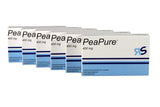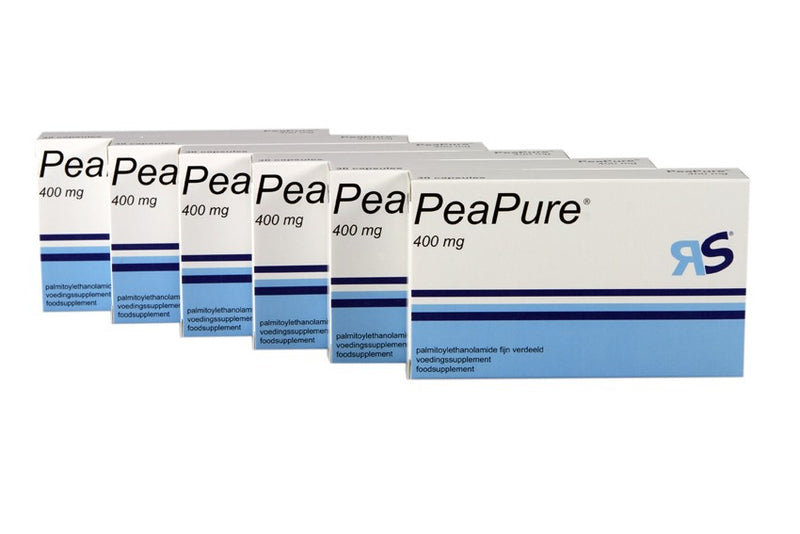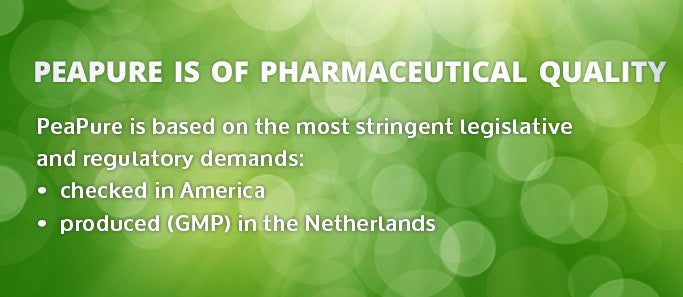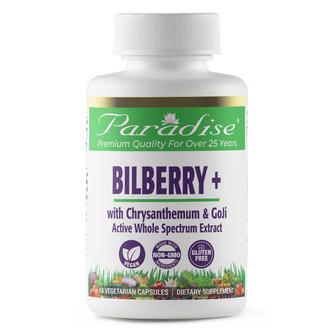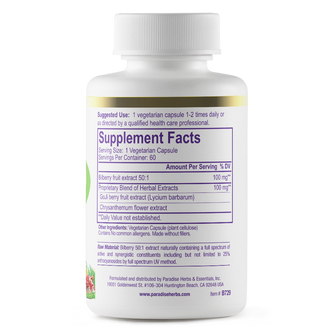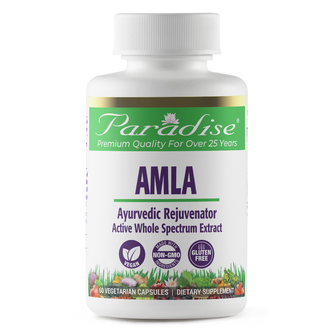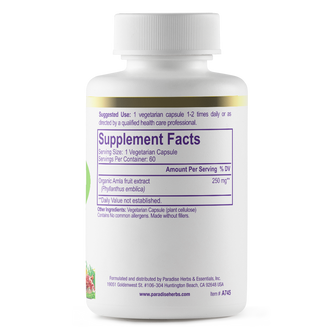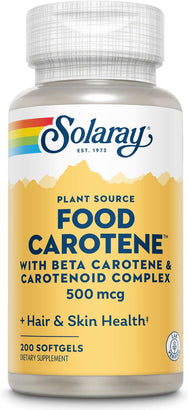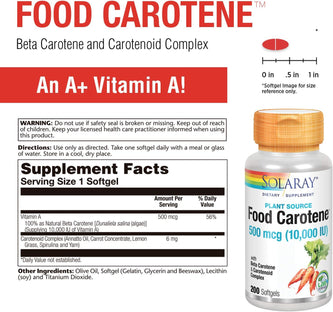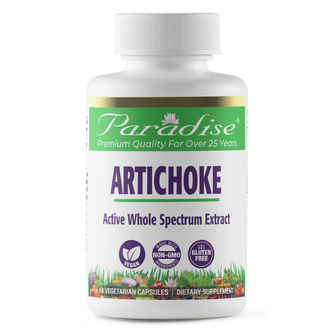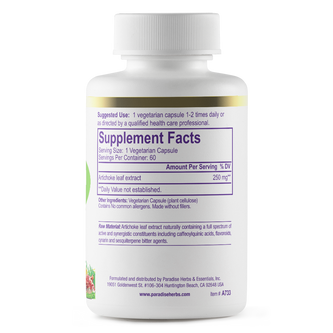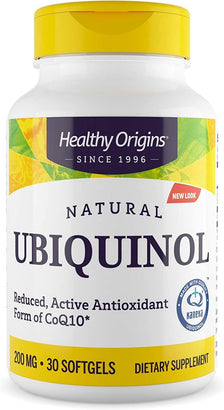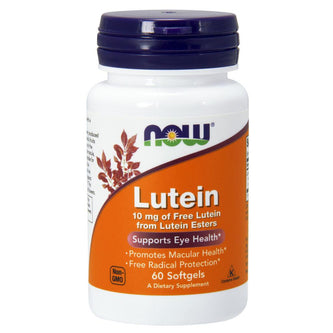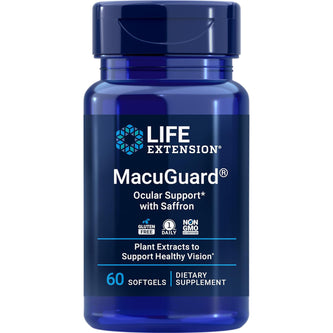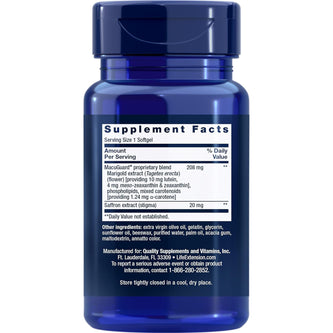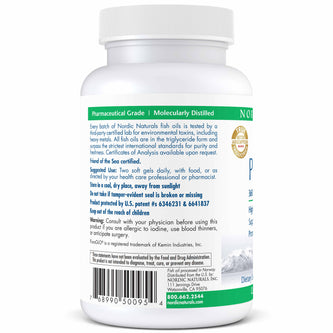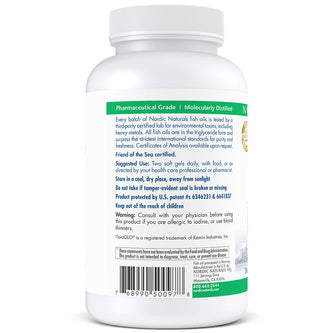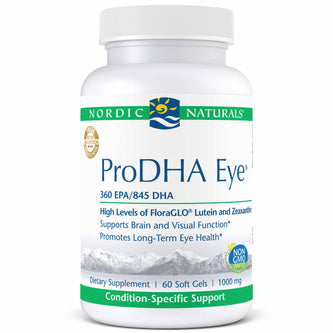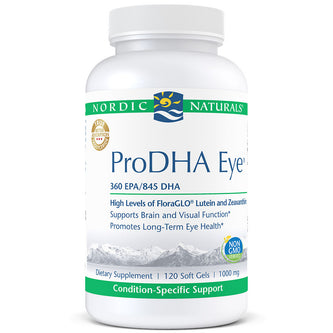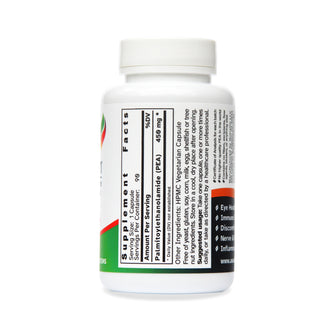Your cart is currently empty
PeaPure 180 Capsules
Quick Overview
Secured and trusted checkout with

We ship these discounted PeaPure bundles immediately (same business day if ordered before 1 PM, otherwise, next business day). Shipping is from the USA. Select your preferred shipping option at checkout. USPS Priority Mail (2-3 day delivery) shipping is available. We can even ship overnight express if you wish! Delivery is to addresses within USA only.
Genuine PeaPure by JP Russell Science Ltd
PeaPure PEA Dietary Supplement
400 mg, 180 capsules (as six boxes of 30 caps in push through blister packs)
Save money on this 180 capsule bundle. (Or get the 30 capsule package here.)
The Genuine 100% PeaPure by JP Russell Science Ltd

- PEA has been described in more than 300 scientific publications.
- PEA was described in 1957 for the first time.
- PEA has already been used by more than a million people all over the world.
- PEA can be used in combination with other products without any problems.
- PEA is a natural substance produced by the human body and found in foods.
- PEA is produced in our body as a biological response and a repair mechanism in chronic inflammation and chronic pain.
- PEA can be found in food such as meat, eggs, soy beans and peanuts.
- New research indicates PEA may be of interest in the treatment of elevated eye pressure and in preventing neurodegeneration in glaucoma. Here it is sold as a dietary supplement and is not offered for the treatment of any disease.
Unique properties of PeaPure
- The most pure PEA product
- A natural substance identical to the body's own
- Optimized formula without stearic acid, magnesium stearate and other ingredients.
- Patent on formulation pending
Information from Wikipedia
- PEA seems to be produced in human as well as in animals as a biological response and a repair mechanism in chronic inflammation and chronic pain.
- Several papers have demonstrated that alterations in the endogenous levels of PEA occur in chronic inflammation. Chronic inflammation is thought to underlie glaucoma.
- PEA has been shown to have anti-inflammatory, anti-nociceptive (anti-pain), neuroprotective, and anticonvulsant properties.
- PEA inhibits the release of both preformed and newly synthesized mast cell mediators, such as histamine and TNF-alpha.
- PEA can also reduce reperfusion injury.
For references, see:
Palmitoylethanolamide - Wikipedia, the free encyclopedia
FAQ
Frequently Asked Questions about PeaPure

General
1. What is PeaPure?
PeaPure is a dietary supplement on the basis of palmitoylethanolamide. Palmitoylethanolamide (PEA for short) is a pure and natural substance which is found in many living creatures and which is physiologically active. In the correct dosage, palmitoylethanolamide can be taken for a prolonged period of time.
After the PEA has first been analyzed and examined in accordance to the most stringent demands in an American laboratory, PeaPure is then produced by a specialized Dutch company in accordance to the highest quality demands of Good Manufacturing Practices (GMP). Therefore, PeaPure is of a pharmaceutical quality and contains, compared with other PEA products, the highest concentration of pure PEA per capsule. PeaPure is guaranteed free of magnesium stearate and other pharmaceutical excipients.
2. What does PeaPure do?
Join the PeaPure discussion at FitEyes.
Scientific articles can be found here: http://www.ncbi.nlm.nih.gov/pubmed/
3. How is PeaPure produced and how is it broken down in our body?
Palmitoylethanolamide, the active ingredient of PeaPure, is a fatty substance made in body cells, mainly in and by those body cells that need this substance. The cells have enzymes that produce palmitoylethanolamide as well as enzymes that break it down into building stones for our body.
4. I now use another product that contains PEA, first as a sublingual powder, after that as a tablet. Can this product be compared with PeaPure?
Both products contain the physiologically active ingredient palmitoylethanolamide (PEA). PeaPure does not contain any chemical additives, flavoring agents, coloring agents or sweeteners.
As the name suggests: PeaPure is pure.
Other products may contain sorbitol.
Some people do not wish to take this sweetener.
PeaPure capsules do not contain sorbitol, just palmitoylethanolamide.
Is it difficult to swallow medium-sized or large tablets?
PeaPure capsules are easy to swallow. They are also easy to open and the palmitoylethanolamide powder can be sprinkled over your food or can be taken with milk or yoghurt.
5. Is PeaPure freely avaiable?
PeaPure is a dietary supplement and therefore freely available for purchase in the USA.
6. What about Refund Policy?
The manufacturer does not allow returns.
Safety/Quality
7. Is it safe to take PeaPure?
To date the active ingredient in PeaPure, palmitoylethanolamide, has been used by more than a million people in Europe: no particular, dangerous or problematic side-effects have been reported.
8. Can PeaPure be taken simultaneously with other substances?
Yes, as far as it is known, there are no other substances that cannot be taken simultaneously with PeaPure. When starting to take PeaPure, it is advisable always to consult with (or update) your doctor, medical specialist or therapist.
9. Is PeaPure safe for people over the age of 65?
Yes, PeaPure can be taken safely by elderly people.
10. Is PeaPure produced according to the highest standards?
After the PEA has first been analyzed and examined in accordance to the most stringent demands in an American laboratory, PeaPure is then produced by a specialized Dutch company in accordance to the highest quality demands of Good Manufacturing Practices (GMP).
Therefore, PeaPure is of a pharmaceutical quality and contains, compared with other PEA products, the highest concentration of pure PEA per capsule.
PeaPure is guaranteed free of stearic acid / magnesium stearate and other pharmaceutical excipients.
Go to top
Dosage
11. When is the best time to take PeaPure?
The best time to take PeaPure is during or after a meal..
12. How much PeaPure should be taken?
It has been shown that taking 1 capsule of 400 mg 3 times a day during the first 2 months is a good starting dosage.
PeaPure users usually notice an improvement during the first few weeks.
Only after two months, the effectiveness of PeaPure can be properly evaluated. From that moment on it will become clear whether it is worthwhile to continue to take PeaPure for a prolonged period of time.
If, after 2 months, the desired effect has been achieved, the dosage can be reduced to 1 capsule of 400 mg 2 times a day.
Starting from 4 months you can consider:
- to continue the dosage of 1 capsule 2 times a day
- to reduce the dosage to 1 capsule 1 time a day
- to stop taking PeaPure.
If the result decreases after reducing the dosage, it is advisable to increase the dosage again to 1 capsule 2 or 3 times a day.
Users should decide for themselves or consult a medical specialist, doctor or therapist whether taking 1 capsule of 400 mg 2 times a day is sufficient as a maintenance dosage or whether it is to be preferred to take a higher dosage of PeaPure.
The capsules are easy to open. If they are difficult to swallow, the fine palmitoylethanolamide powder can be sprinkled over your food or it can be taken with milk or yoghurt.
13. For those people over 65 years of age, should another dosage be taken?
People over the age of 65 can use the normally recommended dosage of 1 capsule of 400 mg PeaPure 2 or 3 times a day.
Expected Results
14. What should be done if the results are not sufficient?
If the result is not sufficient it is advisable to increase the dosage again to 1 capsule 2 or 3 times a day.
15. For how long should PeaPure be taken before results can be noticed?
Generally, the initial results will be noticeable within 2 months after starting to take PeaPure. Depending on various factors, it may take longer for certain users.
Sometimes the results are only noticed when a person stops taking PeaPure, because only then the difference will be clear between taking or not taking PeaPure.
To get the most out of PeaPure, it is advisable to take PeaPure for at least 2 months. This is a realistic evaluation period in order to determine which steps should be taken next. Sometimes it can take a while before a response can be noticed.
16. Why may it take a long period of time before any results are noticeable?
The effectiveness of Palmitoylethanolamide is rendered via natural mechanisms of the body. After starting to take PeaPure, many biological activities occur in the cells and it may take some weeks before any results are noticeable.
17. Does it ever occur that PeaPure does not work?
Yes, that is possible. The desired or expected results may not always be achieved for some people taking PeaPure. As yet, most people react in a positive way to PeaPure. However it is advisable to take PeaPure for at least 2 months before a fair judgement can be made.
Reimbursement
18. Is PeaPure covered by health insurance companies?
No, as PeaPure is a dietary supplement it is generally not covered by health insurance companies.
Research
A new treatment paradigm for Glaucoma?
Ophthalmology Times Europe
Jan 1, 2013
By: Dr Caterina Gagliano
Volume 9, Issue 1
Following on from earlier studies demonstrating that systemic administration of palmitoylethanolamide (PEA), a fatty acid ethanolamide, reduces intraocular pressure (eye pressure or "IOP") in patients with glaucoma and ocular hypertension,1–3 Dr Caterina Gagliano has conducted a further study into the effects of systemic PEA on glaucoma. The results of the study — Clinical trial for the evaluation of neuroprotective effects of palmitoylethanolamide: Visual Field and Pattern-ERG — were communicated through an oral presentation at the EVER congress, held in Nice, France.
While previous studies have focused solely on the eye pressure-lowering effect of PEA, this study increased the dose of PEA administered and measured change in visual field, to assess the impact of PEA on the trabecular meshwork (TM) and its potential neuroprotective activity in glaucoma patients.
Discussing the rationale for the trial and its potential applications in glaucoma, Dr Gagliano explained, "Activation of the glial cells and the consequent neuroinflammatory response is increasingly recognized as a prominent neuropathological feature of glaucoma damage and should therefore be addressed."
About the trial
The prospective, randomised, crossover, double-blind clinical trial evaluated the effects of PEA on intraocular pressure, visual field (VF) and pattern-ERG (PERG) in primary open angle glaucoma (POAG) and ocular hypertension (OH) patients.
Prior to enrolment in the study, the 36 patients included were all receiving topical treatment with timolol 0.5% and had undergone a minimum of five VF tests using the Humphrey Visual Field Analyzer (Threshold 30-2) over a 2-year period. Upon enrolment, study subjects were randomly assigned to either Group A (PEA 300 mg orally twice daily) or Group B (placebo), and were examined at baseline and after 6, 12, 18 and 24 months of treatment. The assessment parameters were change of progression rate of VF using mean deviation (MD) and pattern standard deviation (PSD). Comparison of means was performed with the paired t-test.
"To monitor progressive change of retinal ganglion cell function, we used the pattern electroretinograms twice annually over at least 2 years," noted Dr Gagliano. "The evaluation of the pattern ERG used the amplitude of P50 and N95, and each of the parameters were respected."
Results in traditional parameters
PEA-treated patients experienced a statistically significant reduction in intraocular pressure compared with the eye pressure lowering achieved by subjects receiving placebo (16.94 ± 3.96 vs 13.8 ± 3.24 mmHg; P < 0.001). There was also a statistically significant difference in the MD between the two groups (Group A: –2.9 dB ± 2.93; Group B, –8.55 dB ± 6.51; P = 0.001). The change in PSD reached statistical significance after 24 months of treatment (Group A, 2.64 dB ± 1.47; Group B, 6.59 dB ± 6.51; P = 0.002). PERG amplitude increased significantly (P < 0.01) in Group B patients compared with in Group A patients: at 6, 12, 18 and 24 months, a significant decrease of P50 and N95 amplitude in PEA-treated patients was observed.
"Significant intraocular pressure reduction was observed in Group A," summarized Dr Gagliano. "At 24 months, the mean intraocular pressure decreased 16% from baseline. Additionally, Circadian rhythm variance reduced from baseline by 10%, and a statistically significant difference in the MD was found between the two groups after 12, 18 and 24 months."
Moreover, throughout the 2-year treatment period, PEA medication remained safe and well tolerated, with no drug-related adverse events.
"These findings show substantial clinical benefits of PEA treatment in POAG patients: reduction of intraocular pressure as well as significant improvement in VF and PERG," Dr Gagliano noted. "Based on this evidence we also assessed the relevance of this neuroprotective effect of PEA to treatment in glaucoma patients."
Neuroprotection
Dr Gagliano reported that the reason her team had chosen to research the neuroprotective effect of PEA had been to examine the hypothesis that the effect of PEA — which has been demonstrated to reduce the activation of microglial cells, reducing chronic inflammation — could also work in the same way to preserve or repair cells in glaucoma.
"We believe that targeting the signalling pathways in glial cells responsible for neuroinflammation represents a promising new therapeutic approach in glaucoma," she asserted, adding, moreover, that PEA may also be able to protect against neurotoxicity, and should continue to function even once an insult has been initiated. "Treatment with PEA has an impact on the degree of apoptosis, with up-regulation of pro-apoptotic BAX and down-regulation of anti-apoptotic BCL-2 among the changes," Dr Gagliano noted, to explain this hypothesis.
"All these actions — the intraocular pressure-lowering effect as well as neuroprotection — are mediated by receptor mechanism peroxisome proliferator activated receptor alfa (PPR-alfa) and G-protein coupled receptor 55 (GPR55)."
The future of glaucoma management?
Dr Gagliano concluded her presentation by asserting that, if other clinical trials and laboratory evidence support the results of this study, the treatment paradigm in glaucoma has the potential to shift beyond the current efforts to reduce intraocular pressure and will in addition begin to focus on our ability to preserve visual function for glaucoma patients.
"Although there's still much work to be done in this area, we shouldn't forget what a long way we've already come," she asserted.
References
1. C. Gagliano et al., Invest. Ophthalmol. Vis. Sci., 2011;52(9):6096–6100.
2. A. Kumar et al., Invest. Ophthalmol. Vis. Sci., 2012;53(8):4416–4425.
3. E. Strobbe et al., Invest. Ophthalmol. Vis. Sci., Published on-line before print 10 January 2013, doi: 10.1167/iovs.12-10899
Shipping
Canadian and Australian customers: please order instead this SKU: PeaPure 180 caps PEA
Please ask us if you have any questions!

